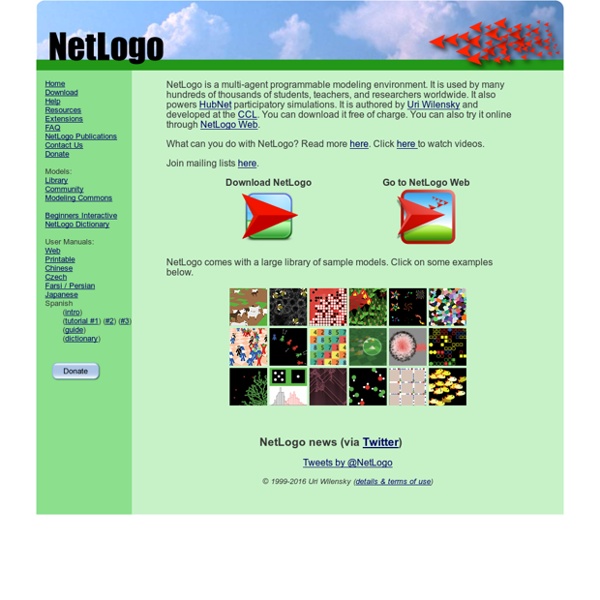



http://ccl.northwestern.edu/netlogo/
Related: NetLogo • RESEARCHFirst Steps with NetLogo First Steps with NetLogo Lets take a few first steps with our modeling frameworks. We will be fairly brief , limiting ourselves to simple "kicking the tires" and writing a hello world in each ABM system (here is the RePast First Steps). Our goal is to gain a feel for what each system is capable of so that we can make intelligent decisions on which one to use for a given task. MASON Multiagent Simulation Toolkit [paper] Keith Sullivan and Sean Luke. 2012. Real-Time Training of Team Soccer Behaviors. In Proceedings of the 2012 RoboCup Workshop. [paper] Keith Sullivan, Katherine Russell, Kevin Andrea, Barak Stout, and Sean Luke. 2012. RoboPatriots: George Mason University 2012 RoboCup Team.
Sampling Distribution Suppose that we draw all possible samples of size n from a given population. Suppose further that we compute a statistic (e.g., a mean, proportion, standard deviation) for each sample. The probability distribution of this statistic is called a sampling distribution. Variability of a Sampling Distribution The variability of a sampling distribution is measured by its variance or its standard deviation. The variability of a sampling distribution depends on three factors: Downloads Gephi is an open-source and multiplatform software distributed under the dual license CDDL 1.0 and GNU General Public License v3. Official Releases Release Notes | System Requirements | Installation instructions Gephi 0.9.2 is the latest stable release. Download Gephi for LinuxVersion 0.9.2 If you have an older Gephi on your computer, you should uninstall it first, see the installation instructions.
GIS Extension This extension adds GIS (Geographic Information Systems) support to NetLogo. It provides the ability to load vector GIS data (points, lines, and polygons), and raster GIS data (grids) into your model. The extension supports vector data in the form of ESRI shapefiles. The shapefile (.shp) format is the most common format for storing and exchanging vector GIS data. CoolWorld This applet requires Java 1.4.1 or higher. You may obtain the latest Java plugin from Sun's Java site. created with NetLogoview/download model file: CoolWorld.nlogo CoolWorld is an agent-based model designed to illustrate the usefulness of the theory of Markov chains to analyse computer models. This section explains the formal model that CoolWorld implements. The information provided here should suffice to re-implement the same formal model in any sophisticated enough modelling platform.
Home Simplify your research! Plan your research project with the help of SAGE Research Methods. With SAGE Research Methods, faculty, students, and researchers can: Learn how to design a research project Discover new methods to use in your research with the Methods Map Read over 175,000 pages of SAGE's renowed research methods content from leading global authors Browse content from over 720 books, dictionaries, encyclopedias, and handbooks Share content with colleagues and research partners using Methods Lists Explore related online journal content with the SAGE Journals widget Watch a video that answers key questions about research methods Click here to recommend SAGE Research Methods to your library.
Binomial Distribution To understand binomial distributions and binomial probability, it helps to understand binomial experiments and some associated notation; so we cover those topics first. Binomial Experiment A binomial experiment (also known as a Bernoulli trial) is a statistical experiment that has the following properties: The experiment consists of n repeated trials. Each trial can result in just two possible outcomes. We call one of these outcomes a success and the other, a failure.
Open Agent Based Modeling Consortium NetLogo 4.1 Tutorial #1: Models Learn about the features available in NetLogo while exploring the Models library. (Provided by the NetLogo development team) NetLogo 4.1 Tutorial #2: Commands 100 Search Engines For Academic Research Back in 2010, we shared with you 100 awesome search engines and research resources in our post: 100 Time-Saving Search Engines for Serious Scholars. It’s been an incredible resource, but now, it’s time for an update. Some services have moved on, others have been created, and we’ve found some new discoveries, too. Many of our original 100 are still going strong, but we’ve updated where necessary and added some of our new favorites, too.
Six Sigma The common Six Sigma symbol Six Sigma is a set of techniques and tools for process improvement. It was developed by Motorola in 1986.[1][2] Jack Welch made it central to his business strategy at General Electric in 1995.[3] Today, it is used in many industrial sectors.[4] Six Sigma seeks to improve the quality of process outputs by identifying and removing the causes of defects (errors) and minimizing variability in manufacturing and business processes. It uses a set of quality management methods, mainly empirical, statistical methods, and creates a special infrastructure of people within the organization ("Champions", "Black Belts", "Green Belts", "Yellow Belts", etc.) who are experts in these methods. Each Six Sigma project carried out within an organization follows a defined sequence of steps and has quantified value targets, for example: reduce process cycle time, reduce pollution, reduce costs, increase customer satisfaction, and increase profits.